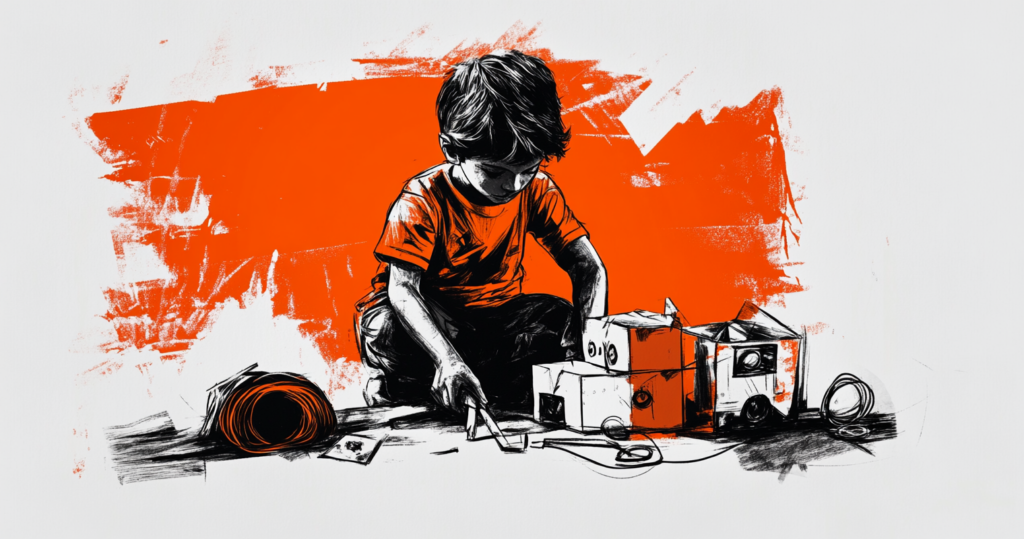Yesterday, I watched my eight-year-old disappear into his work.
He’d grabbed a leftover cardboard box from the Murphy bed I was installing and was attempting to build what he called a “robot.” For twenty minutes, he was completely absorbed, measuring with his hands, marking with a pencil stub, cutting with scissors with intense concentration. His face cycled through pure focus, bursts of joy when something worked, and genuine frustration when his vision didn’t match reality.
That’s when it hit me: this is exactly what I looked like in Mr. Benson’s shop class thirty years ago.
I was listening to Mike Rowe’s podcast recently, and he was talking with Tim Allen about something that struck me right in the chest: the loss of Industrial Arts in our schools. Not just shop class, but the whole ecosystem of learning that came with it. As I watched my son work through his “robot” problem, I realized we might be missing something crucial about how we’re raising our boys.
The Classroom That Built More Than Birdhouses
Shop class wasn’t just about learning to use a table saw or weld a joint. It created a complete learning environment that played to strengths many of our boys naturally possess: the need to move, to problem-solve with their hands, to see immediate results from their efforts.
I remember building a chair in Mr. Benson’s class. My first design had the seat height at 20 inches because that felt comfortable to me. I’m 6’1″, so of course it did. But when I actually measured existing chairs, they were all around 17–18 inches. Suddenly, I had to think beyond my own perspective. What about someone who’s 5’2″? What about kids? What about elderly people who might struggle getting up from a chair that’s too low?
That chair taught me empathy in a way no lecture ever could.
The Science of How Boys Learn
Research consistently shows that many boys learn better through hands-on, kinesthetic experiences. A study published in the Journal of Educational Psychology found that boys, on average, show greater improvement in spatial reasoning and problem-solving skills through physical manipulation of objects compared to abstract instruction alone.
The traditional classroom setup often works against many boys’ natural learning styles. As Dr. Leonard Sax points out in Boys Adrift, sitting still, listening quietly, and focusing on fine motor skills like handwriting can feel like obstacles rather than opportunities. Meanwhile, shop classes provided an environment where their need for movement, their tendency toward spatial thinking, and their desire to see concrete results actually became advantages.
What we’ve lost goes deeper than learning styles. These programs taught patience through necessity. You couldn’t rush a dovetail joint. You couldn’t fake your way through a weld. The work itself demanded precision, persistence, and problem-solving. And when you finally held that finished project (whether it was a cutting board or a small engine you’d rebuilt) you felt something that’s hard to replicate in our digital age: genuine pride in creation.
The Confidence That Comes From Competence
There’s something profound that happens when a boy learns he can take raw materials and transform them into something useful. It builds what I call “quiet confidence,” not the loud, performative kind, but the steady knowledge that you can figure things out, that you can create solutions with your own hands.
This kind of competence creates a foundation that extends far beyond the workshop.
I see this in my boys when they’re building. When my eight-year-old successfully engineers a way to make his cardboard robot’s arm actually bend at the elbow, he doesn’t just feel smart, he feels capable. He’s learned that he can impose his will on the physical world, that obstacles are just problems waiting to be solved.
This confidence transfers. Boys who feel competent with tools and materials often feel more competent in other areas too. They’ve learned that failure isn’t final, it’s just feedback. The board you cut too short teaches you to measure twice. The joint that doesn’t fit teaches you patience. The project that turns out better than you expected teaches you that you’re capable of more than you knew.
The Empathy Hidden in Every Project
Here’s something I didn’t expect Industrial Arts to teach: consideration for others. Almost everything you build is ultimately for someone else. That chair needs to be comfortable for the person sitting in it. The bookshelf needs to hold the books your wife actually owns. The birdhouse needs to work for the birds, not just look good to you.
When my boys are building something, I watch them naturally start thinking about the end user. “Dad, do you think this is tall enough for Mom?” “Would this work for someone who’s not as strong as me?” They’re learning to step outside their own perspective and consider how their work affects others.
This is masculinity at its best: using your strength and skills not just for yourself, but to add value to other people’s lives.
Building the Experience Today
So what do we do with this knowledge? We can’t single-handedly bring back Industrial Arts programs, but we can create similar experiences for our boys.
Start with real projects. Not crafts, not busy work, but actual things your family needs. Last month, my son and I built a simple spice rack for his mom. He measured, I cut, he sanded. When she uses it every day, he lights up. Let your kids see that their effort creates real value. Fix something together instead of replacing it.
Embrace the mess. Home Depot’s monthly kids’ workshops are brilliant for this. Community colleges often offer parent-child classes in woodworking or basic mechanics. These aren’t about producing perfect results, they’re about learning the process and building confidence through doing.
Create a space for building. Even if it’s just a corner of the garage with a small workbench and basic tools. Give your boys permission to experiment, to fail, to try again. Stock it with scrap wood and let them create.
Model the mindset. When something breaks, resist the urge to just buy a new one. Show your boys that problems are opportunities to figure things out. Let them see you think through challenges, measure twice, cut once, and sometimes start over when the first approach doesn’t work.
The House I Built
I’ll be honest, I’m probably biased about all this. I tore our last house down to the studs and rebuilt it from the foundation up. There wasn’t a part of that house I didn’t touch with my own hands. Before we moved, I’d sometimes catch myself standing in the yard with my kids, just looking at it. “I built that house,” I’d think. Not just hired someone to build it, not just supervised the work, I actually built it.
That feeling? That’s what I want my boys to experience. Not necessarily with a whole house, but with something. The knowledge that they can take raw materials, apply skill and persistence, and create something that wasn’t there before. Something useful. Something that adds value.
Because in a world that often feels chaotic and beyond our control, there’s something deeply satisfying about knowing you can build solutions with your own hands. And there’s something essential about raising boys who carry that quiet confidence with them into everything else they do.
The Work Continues
As I finished writing this, my son came in to show me his “robot.” It doesn’t look like much: a cardboard box with cut-out holes, some tape, and string for the “cables.” But it works. Sort of. And the pride on his face as he demonstrated how the arm joint bends?
That’s exactly what we’re building toward. Not just projects, but people. Not just skills, but character. Not just boys who can work with their hands, but men who understand that real strength comes from using your abilities to create value for others.
Shop classes might be gone from most schools, but the lessons they taught are still desperately needed. And the good news? We don’t need a classroom to teach them. We just need to be willing to get our hands dirty and show our boys that building things (whether it’s furniture, confidence, or character) is always worth the effort.
The Focused Fool Newsletter. Growing As Men. Leading As Fathers.


Leave a Reply